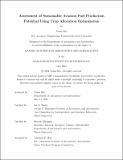Assessment of Sustainable Aviation Fuel Production Potential Using Crop Allocation Optimization
Author(s)
Shu, Yuxin
DownloadThesis PDF (5.696Mb)
Advisor
Waitz, Ian A.
Allroggen, Florian
Terms of use
Metadata
Show full item recordAbstract
Sustainable aviation Fuel (SAF) has been recognized as a viable solution in the near to medium future for decreasing carbon emissions in the aviation industry. Global SAF production, however, is limited and falls well short of the International Air Transport Association’s (IATA) goal to achieve net-zero carbon emissions in 2050. This thesis quantifies the global SAF production potential through different crop allocation strategies. Biomass potential is quantified by land suitability and agricultural availability. An optimization model is developed using binary integer linear programming with three crop allocation strategies for 2050 and 2100: fuel maximization, emissions minimization, and land use minimization. The results are shown through six case studies: the United Kingdom, Japan, Australia, Kenya, Brazil, and the United States. Under the Intergovernmental Panel on Climate Change (IPCC) climate scenarios, the globally suitable land can meet and exceed the requirement for biomass cultivation for the aviation sector from the International Energy Agency (IEA). The demand for jet fuel in the U.S. can be fulfilled with 100% SAF, resulting in 21.3% emission savings if optimized for minimum emissions and assuming the use of energy crops. Incorporating lignocellulosic biomass could result in an additional 63.8% reduction in emissions. The study also shows that Japan and the United Kingdom have insufficient agricultural potential to meet their respective domestic SAF demands. In contrast, Australia, Kenya, Brazil, and the United States have agricultural potential that meet or exceed their relative SAF needs.
Date issued
2024-05Department
Massachusetts Institute of Technology. Department of Aeronautics and AstronauticsPublisher
Massachusetts Institute of Technology